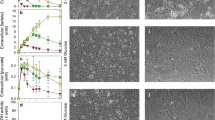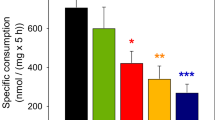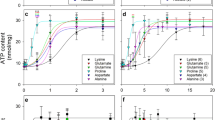Abstract
Since malate is known to play an important role in a variety of functions in the brain including energy metabolism, the transfer of reducing equivalents and possibly metabolic trafficking between different cell types; a series of biochemical determinations were initiated to evaluate the rate of14CO2 production froml-[U-14C]malate in primary cultures of rat brain astrocytes. The14CO2 production from labeled malate was almost totally suppressed by the metabolic inhibitors rotenone and antimycin A suggesting that most of malate metabolism was coupled to the electron transport system. A double reciprocal plot of the14CO2 production from the metabolism of labeled malate revealed biphasic kinetics with two apparent Km and Vmax values suggesting the presence of more than one mechanism of malate metabolism in these cells. Subsequent experiments were carried out using 0.01 mM and 0.5 mM malate to determine whether the addition of effectors would differentially alter the metabolism of high and low concentrations of malate. Effectors studied included compounds which could be endogenous regulators of malate metabolism and metabolic inhibitors which would provide information regarding the mechanisms regulating malate metabolism. Both lactate and aspartate decreased14CO2 production from 0.01 mM and 0.5 mM malate equally. However, a number of effectors were identified which selectively altered the metabolism of 0.01 mM malate including aminooxyacetate, furosemide, N-acetylaspartate, oxaloacetate, pyruvate and glucose, but had little or no effect on the metabolism of 0.5 mM malate. In addition, α-ketoglutarate and succinate decreased14CO2 production from 0.01 mM malate much more than from 0.5 mM malate. In contrast, a number of effectors altered the metabolism of 0.5 mM malate more than 0.01 mM. These included methionine sulfoximine, glutamate, malonate, α-cyano-4-hydroxycinnamate and ouabain. Both the biphasic kinetics and the differential action of many of the effectors on the14CO2 production from 0.01 mM and 0.5 mM malate provide evidence for the presence of more than one pool of malate metabolism in cultured rat brain astrocytes.
Similar content being viewed by others

References
Shank, R. P., and Campbell, G. LeM. 1984. α-ketoglutarate and malate uptake and metabolism by synaptosomes: Further evidence for an astrocyte-to-neuron metabolic shuttle. J. Neurochem. 42:1153–1161.
Shank, R. P., and Campbell, G. LeM. 1984. Amino acid uptake, content and metabolism by neuronal and glial enriched cellular fractions from mouse cerebellum. J. Neurosci. 4:58–69.
Yu, A. C., Hertz, E., Schousboe, A., and Hertz, L. 1984. Uptake and metabolism of malate in cultures of astrocytes and neurons. Transact. Am. Soc. Neurochem. 15:A216.
Hawkins, R. A., and Mans, A. M. 1983. Intermediary metabolism of carbohydrates and other fuels. Pages 259–294, in Lajtha, A. (ed.), Handbook of Neurochemistry, Vol. 3 Second Edition, Plenum Press, New York.
Hindfelt, B., Plum, F., and Duffy, T. E. 1977. Effect of acute ammonia intoxication on cerebral metabolism in rats with portacaval shunts. J. Clin. Invest. 59:386–396.
Ozand, P. T., Stevenson, J. H., Tildon, J. T., and Cornblath, M. 1975. The effects of hyperketonemia on glutamate and glutamine metabolism in developing rat brain. J. Neurochem. 25:67–71.
Shank, R. P., Schneider, C. R., and Tighe, J. J. 1987. Ion dependence of neurotransmitter uptake: inhibitory effects of ion substitutes. J. Neurochem. 49:381–388.
Salganicoff, L., and Koeppe, R. E. 1968. Subcellular distribution of pyruvate carboxylase, diphosphopyridine nucleotide and triphosphopyridine nucleotide isocitrate dehydrogenases, and malate enzyme in rat brain. J. Biol. Chem. 243:3416–3420.
Dennis, S. C., and Clark, J. B. 1978. The regulation of glutamate metabolism by tricarboxylic acid-cycle activity in rat brain mitochondria. Biochem. J. 172:155–162.
Fitzpatrick, S. M., Cooper, A. J. L., and Duffy, T. E. 1983. Use of β-methylene-D, L-aspartate to assess the role of aspartate aminotransferase in cerebral oxidative metabolism. J. Neurochem. 41:1370–1383.
Murthy, Ch. R. K., and Hertz, L. 1988. Pyruvate decarboxylation in astrocytes and in neurons in primary cultures in the presence and the absence of ammonia. Neurochem. Res. 13:57–61.
Lai, J. C. K., Murthy, Ch. R. K., Cooper, A. J. L., Hertz, E., and Hertz, L. 1989. Differential effects of ammonia and β-methylene-D, L-aspartate on metabolism of glutamate and related amino acids by astrocytes and neurons in primary culture. Neurochem. Res. 14:377–389.
Sokoloff, L., Fitzgerald, G. G., and Kaufman, E. E. 1977. Cerebral nutrition and energy metabolism. Pages 87–139, in Wurtman, R. J. and Wurtman, J. J. (eds.), Nutrition and the Brain, Vol. 1, Raven Press, New York.
Cremer, J. E. 1981. Nutrients for the brain: Problems in supply. Early Hum. Develop. 5:117–132.
Balazs, R., and Cremer, J. E., (eds.), 1973. Metabolic Compartmentation in the Brain, Macmillan Press, London.
Berl, S., Clarke, D. D., and Schneider, D., (eds.), 1975. Metabolic Compartmentation and Neurotransmission: Relation to Brain Structure and Function, Plenum Press, New York.
Hertz, L. 1979. Functional interactions between neurons and astrocytes. I. Turnover and metabolism of putative amino acid neurotransmitters. Prog. Neurobiol. 13:277–323.
Tildon, J. T., and Roeder, L. M. 1987. Metabolic regulation in brain cells. Pages 383–402, in Vernadakis, A., Privat, A., Louder, J. M., Timeras, P. S. and Giacobini, E. (eds.) Model Systems of Development and Aging of the Nervous System, Martinus Nijhoff, Boston.
Edmond, J., Auestad, N., Korsak, R. A., Cole, R. A., and de Vellis, J. 1988. Specialization in substrate oxidation by astrocytes from developing brain. Transact. Am. Soc. Neurochem. 19:A78.
Yudkoff, M., Nissim, I., and Pleasure, D. 1988. Astrocyte metabolism of15N and13C glutamine: Implications for the glutamine-glutamate cycle. FASEB J. 2:A637.
Nicklas, W. J., Berl, S., and Clark, D. D. 1975. Relationship between amino acid and catecholamine metabolism in brain. Pages 497–513,in Berl, S., Clarke, D. D. and Schneider, D. (eds.) Metabolic Compartmentation and Neurotransmission: Relation to Brain Structure and Function, Plenum Press, New York.
Nicklas, W. J., and Krespan, B. 1982. Studies on neuronal-glial metabolism of glutamate in cerebellar slices. Pages 383–394,in Bradford, H. F. (ed.), Neurotransmitter Interaction and Compartmentation, Plenum Press, New York.
Roeder, L. M., Tildon, J. T., and Stevenson, J. H., Jr. 1984. Competition among oxidizable substrates in brains of young and adult rats. Whole homogenates. Biochem J. 219:125–130.
Roeder, L. M., Tildon, J. T., and Holman, D. C. 1984. Competition among oxidizable substrates in brains of young and adult rats. Dissociated cells. Biochem. J. 219:131–135.
McKenna, M. C., Bezold, L. I., Kimatian, S. J., and Tildon, J. T. 1986. Competition of glycerol with other oxidizable substrates in rat brain. Biochem. J. 237:47–51.
Tildon, J. T., Roeder, L. M., and Stevenson, J. H. 1985. Substrate oxidation by isolated rat brain mitochondria and synaptosomes. J. Neurosci. Res. 14:207–215.
Roeder, L. M., Williams, I. B., and Tildon, J. T. 1985. Glucose transport in astrocytes: Regulation by thyroid hormone. J. Neurochem. 45:1653–1657.
Hertz, L., Juurlink, B. H. J., Fosmark, H., and Schousboe, A. 1982. Astrocytes in primary culture. Pages 175–186,in Pfeiffer S. E. (ed.), Neuroscience Approached Through Cell Culture, Vol. 1, CRC Press, Boca Raton.
Booher, J., and Sensenbrenner, M. 1972. Growth and cultivation of dissociated neurons and glial cells from embryonic chick, rat and human brain in flask cultures. Neurobiology 2:97–105.
Bock, E., Moller, M., Nissen, C., and Sensenbrenner, M. 1977. Glial Fibrillary acidic protein in primary astroglial cell cultures derived from newborn rat brains. FEBS Lett. 83:207–211.
Schousboe, A. 1980. Primary cultures of astrocytes from mammalian brain as a tool in neurochemical research. Cell. Mol. Biol. 26:505–513.
Fedoroff, S., White, R., Subrahmanyan, L., and Kalnins, V. I. 1981. Properties of putative astrocytes in colony cultures of mouse neopallium. Pages 1–19,in Vidrio, E. A., and Fedoroff, S. (eds.), Eleventh International Congress of Anatomy: Glial and Neuronal Cell Biology, Alan R. Liss, New York.
Smith, P. K., Krohn, R. I., Hermanson, G. T., Mallia, A. K., Gartner, F. H., Provenzano, M. D., Fujimoto, E. K., Goeke, N. M., Olson, B. J., and Klenk, D. C. 1985. Measurement of protein using bicinchoninic acid. Anal. Biochem. 150:76–85.
Fitzpatrick, S. M., Cooper, A. J. L., and Hertz, L. 1988. Effects of ammonia and β-methylene-D, L-aspartate on the oxidation of glucose and pyruvate by neurons and astrocytes in primary culture. J. Neurochem. 51:1197–1203.
Snedecor, G. W., and Cochran, W. G. 1967. Statistical Methods, Sixth Edition, Iowa State University Press, Ames.
Matchett, P. A., and Johnson, J. A. 1954. Inhibition of sodium and potassium transport in frog sartorii in the presence of ouabain. Fed. Proc. 13:384.
Whittam, R. 1962. The asymmetrical stimulation of membrane adenosine triphosphatase in relation to activation transport. Biochem. J. 84:110–118.
Burg, M. B. 1976. Tubular chloride transport and the mode of action of some diuretics. Kidney Int. 9:189–197.
Rodman, M. J., Karch, A. M., Boyd, E. H., and Smith, D. W. 1985. Pharmacology and Drug Therapy in Nursing, J. B. Lippincott Co., Philadelphia.
Cooper, A. J. L., Fitzpatrick, S. M., Ginos, J. Z., Kaufman, C., and Dowd, P. 1983. Inhibition of glutamate-aspartate transaminase by β-methylene-D, L-aspartate. Biochem. Pharmacol. 32:679–689.
Koeppen, A. H., and Riley, K. M. 1987. Effect of free malonate on the utilization of glutamate by rat brain mitochondria. J. Neurochem. 48:1509–1515.
Smith, S. B., Briggs, S., Triebwasser, K. C., and Freedland, R. A. 1977. Re-evaluation of amino-oxyacetate as an inhibitor. Biochem. J. 162:453–455.
Cheeseman, A. J., and Clark, J. B. 1988. Influence of the malate-aspartate shuttle on oxidative metabolism in synaptosomes. J. Neurochem. 50:1559–1565.
Bender, A. S., Woodbury, D. M., and White, H. S. 1988. Metabolic and ionic dependence of glutamate uptake into astrocytes in primary culture. Transact. Am. Soc. Neurochem. 19:A172.
Shank, R. P., and Campbell, G. LeM. 1982. Glutamine and alpha-ketoglutarate uptake and metabolism by nerve terminal enriched material from mouse cerebellum. Neurochem. Res. 7:601–611.
Hagenfeldt, L., Bollgren, I., and Venizelos, N. 1987. N-acetyl-aspartic aciduria due to aspartatoacylase deficiency—a new aetiology of childhood leukodystrophy. J. Inherited Metab. Dis. 10:135–141.
Lehninger, A. L. 1970. Biochemistry, Worth Publishers, Inc., New York.
Williamson, D. H., Lund, H. P., and Krebs, H. A. 1967. The redox state of free nicotinamide-adenine dinucleotide in the cytoplasm and mitochondria of rat liver. Biochem. J. 108:514–527.
Duffy, T. E., Nelson, S. R., and Lowry, O. H. 1972. Cerebral carbohydrate metabolism during acute hypoxia and recovery. J. Neurochem. 19:959–977.
Shank, R. P., and Aprison, M. H. 1988. Glutamate as a neurotransmitter. Pages 3–19, in Kvamme, E. (ed.), Glutamate and Glutamine in Mammals, Vol. 2, CRC Press, Inc., Boca Raton.
Weiler, C. T., Nystrom, B., and Hamberger, A. 1979. Characteristics of glutamine vs. glutamate transport in isolated glia and synaptosomes. J. Neurochem. 32:559–565.
McKenna, M. C., Tildon, J. T., Stevenson, J. H., Couto, R., and Caprio, F. J. 1989. Stimulation of malate release from astrocytes by glutamate. Transact. Am. Soc. Neurochem. 20:A191.
Subbalakshmi, G. Y. C. V., and Murthy, Ch. R. K. (1983). Effects of methionine sulfoximine on the enzymes of glutamate metabolism in isolated astrocytes of rat brain. Biochem. Pharmacol. 32:3695–3700.
Ratnakumari, L., Subbalakshmi, G. Y. C. V., and Murthy, Ch. R. K. 1985. Cerebral citric acid cycle enzymes in methionine sulfoximine toxicity. J. Neurosci. Res. 14:449–459.
Oh, Y. J., Markelonis, G. J., and Oh, T. H. 1988. Evidence for the existence of subtypes of type-1 rat astrocytes in culture. Society for Neuroscience Meeting Abstract 173.7.
Webb, J. L. 1966. Enzyme and Metabolic Inhibitors, Vol. 2, Academic Press, New York.
Shank, R. P., and Campbell, G. LeM. 1984. Glutamine, glutamate and other possible regulation of α-ketoglutarate and malate uptake by synaptic terminals. J. Neurochem. 42:1162–1169.
Mitzen, E. J., and Koeppen, A. H. 1984. Malonate, malonylcoenzyme A, and acetyl-coenzyme A in developing rat brain. J. Neurochem. 43:499–506.
Spencer, T. L., and Lehninger, A. L. 1976.l-lactate transport in Ehrlich ascites-tumor cells. Biochem. J. 154:405–414.
Trimmer, P. A., Reier, P. J., Oh, T. H., and Eng, L. F. 1982. An ultrastructural and immunocytochemical study of astrocyte differentiation in vitro. J. Neuroimmunol. 2:235–260.
Author information
Authors and Affiliations
Rights and permissions
About this article
Cite this article
McKenna, M.C., Tildon, J.T., Couto, R. et al. The metabolism of malate by cultured rat brain astrocytes. Neurochem Res 15, 1211–1220 (1990). https://doi.org/10.1007/BF01208582
Accepted:
Issue Date:
DOI: https://doi.org/10.1007/BF01208582



